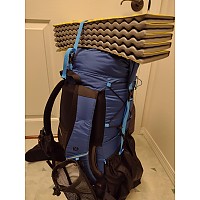Salomon X Ultra 3 GTX
The X Ultra 3 GTX has been discontinued. It was replaced by the Salomon X Ultra 4 GTX.
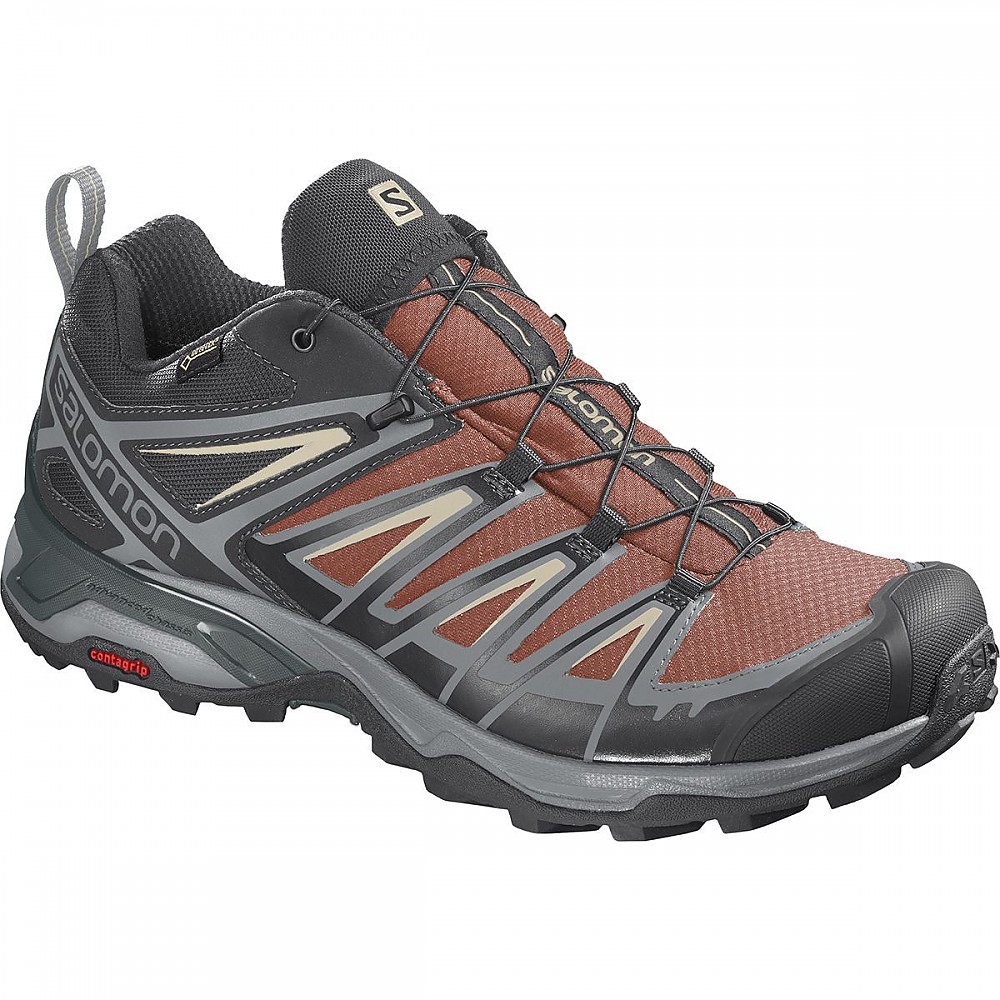
These low hikers were an upgrade from Salomon's XA Pro 3D trail running shoes for me that was well worth the extra investment. The shoe provides excellent support and foot protection for a lightweight shoe, and waterproofing has proved to be durable. Grippy soles showed a fair bit of wear after 18 months, and potential buyers should note the speed lacing system. A great all-around light hiking shoe.
Pros
- Support
- Traction
- Waterproofing
- Light weight
- Width sizing
- Durability
Cons
- Stiff midsole benefits from some break-in
- Stock insoles
You will note that this review looks at two pair of this shoe side-by-side. That is because the midsole is sufficiently flattened that I decided to get a new pair, and I thought it would help to compare a brand new pair with the well-worn shoes being replaced.
Fair warning: I spend enough time photographing Trailspace Review Corps shoes that I gave myself a break with these. I don't have any photos of the many months of walking and hiking I did in the older pair. For what it's worth, I average about 2,600 miles of walking per year, with about 1,400 of those miles from hiking/walking at a healthy pace, and the rest from the daily moving around I do. I work in a job where I can normally wear anything from dress shoes to light hikers to my most robust leather boots to work.
The Basics
The X Ultra 3 weighs 1.9 pounds, new out of the box. That's lighter than the heavy-duty trail runners they replaced. They have a fairly typical construction—synthetic upper (some nylon, some synthetic leather), an EVA midsole that feels firm with some hard plastic exterior reinforcement around the heel area, and an aggressively-lugged Contagrip sole.
The shoes also have a solid toe bumper, a heel loop, and thin kevlar speed laces.
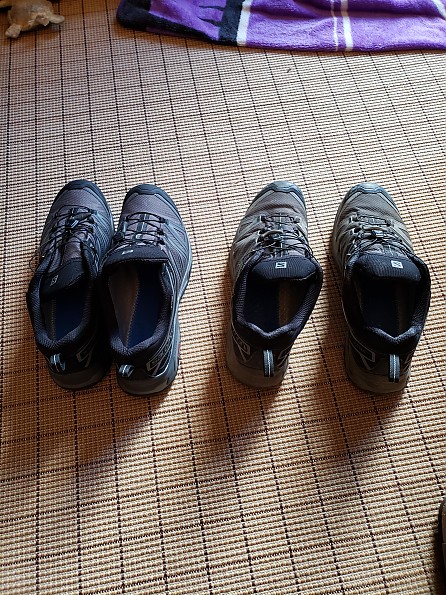
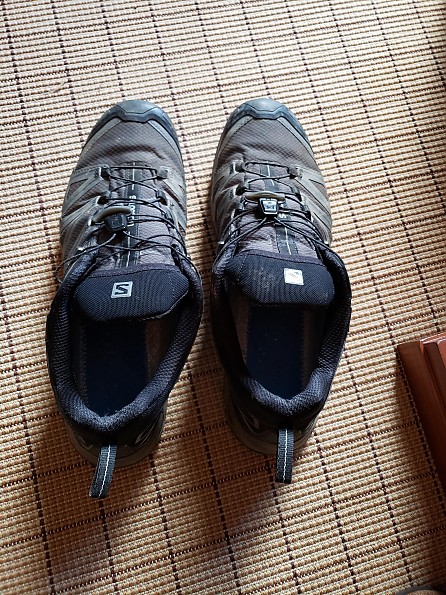
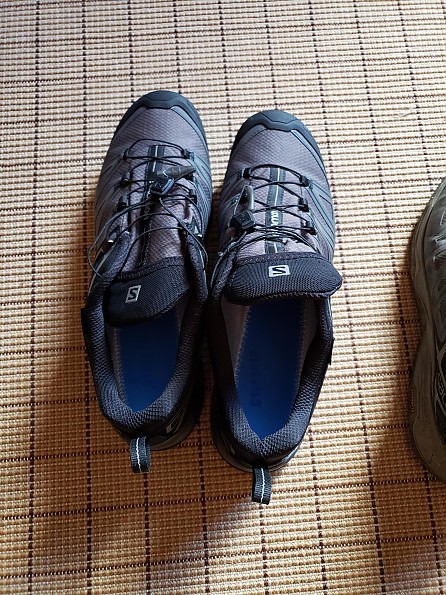
Fit and Comfort
Salomon became my light hiking shoe of choice because the orthopedist who built my last pair of orthotics suggested they offer more support than the shoes I was wearing, as well as width sizing to accommodate my wider feet plus a fairly robust custom orthotic. I wear a size 12 wide, and they are a good fit in this shoe. They run pretty much true to size; I normally buy hiking shoes a half size larger than normal because it helps me limit toe bang on downhills.
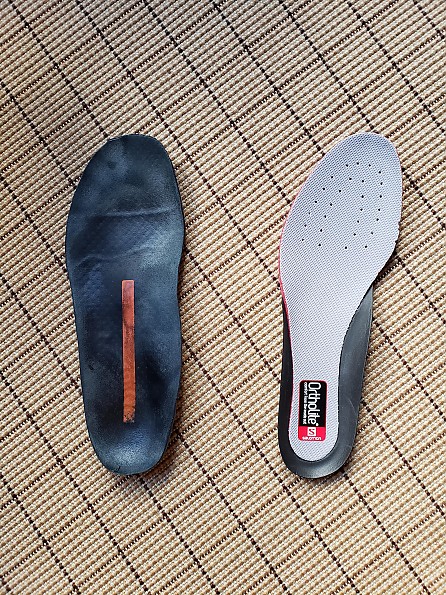
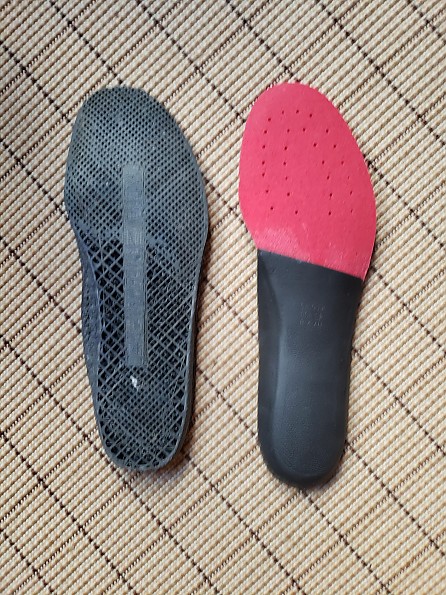
This has been a very firm-fitting shoe for me with light or medium-weight ankle or quarter-high running or wool socks. The speed laces are easy to pull tight, and the midsole has limited flex at first, though the midsole does soften and gain some flexibility over time. In part, the firmness of the midsole comes from an embedded molded (probably some kind of poly or plastic) shank.
The shank makes this feel like a firmer, more stable shoe than any trail runner I have worn, so this feels like a very solid low hiking shoe despite its light weight. By solid, I mean limited flex walking heel to toe that loosens up a bit over time, and very good lateral stability.
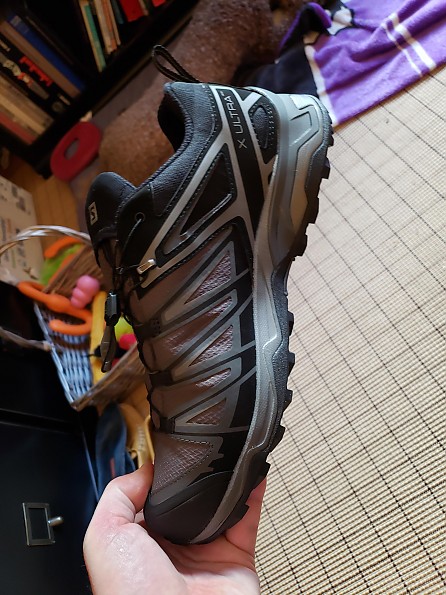
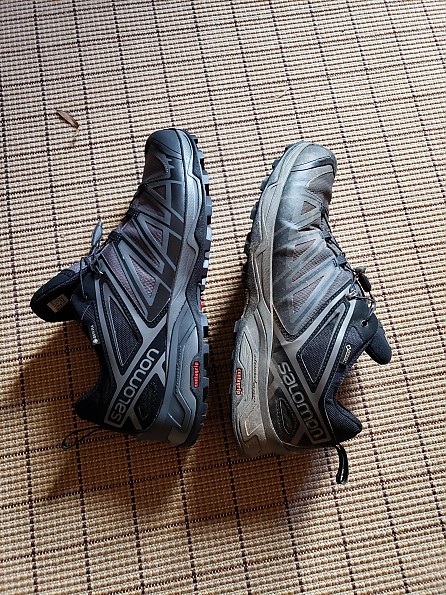
To put things in perspective, I have toted 30-40 pounds on my back in these shoes without any meaningful adverse impact or fatigue in my feet. It's a low shoe, so it doesn't provide any ankle coverage or support, but the firmness of this shoe provides a solid base.
Waterproofing
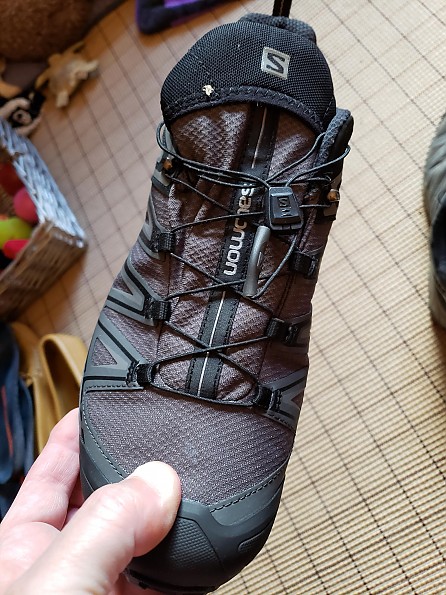
The X Ultra 3 Gore-tex surrounds your foot up to the point where the tongue extends up past your instep. It has consistently kept my feet dry through 18 months of wear. Anticipate that in a steady rain, the top part of the tongue will get wet and eventually get the upper part of your sock wet.
Like any Gore-tex shoe, this does not breathe as well as a non-waterproof shoe. If you live in a hot, dry area, the X Ultra 3 is available without Gore-tex, the "Aero" version. I looked at the Aero, and it's interesting that the fabric sections are not only made from a more air-permeable nylon, but they also have a slightly more forgiving fit due to that more stretchy material.
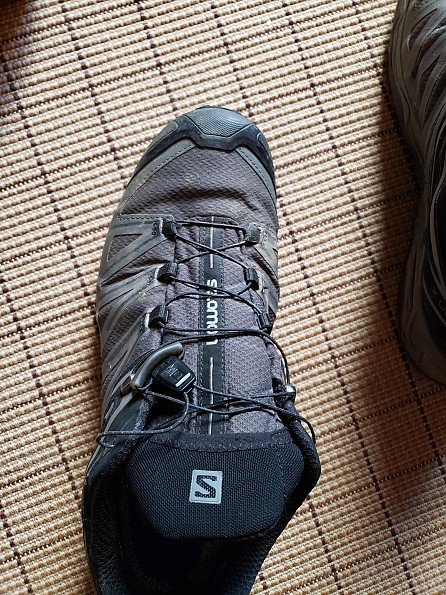
Speed Laces
My sense of speed laces is that people tend to have a love/hate relationship with them. If you don't like them but want to explore this shoe, consider Salomon's X Ultra 3 Mid GTX, which has regular shoelaces. I don't mind the speed laces, but keep in mind that they tend to redistribute pressure across the entire lacing system. With regular laces, you can isolate certain sections to make them tighter by using alternative lacing strategies—that's just not an option with speed laces.
Also, speed laces, particularly Kevlar, are extremely durable, so much that they have the potential to rub against and wear through a shoe's fabric. Kudos to Salomon, because the way these speed laces lie against the shoe, they haven't created any of those wear issues. They have, on the other hand, proved to be highly durable.
The speed laces have a plastic piece at the top of the system. You pull the laces tight through the plastic piece, and the laces do not slip back through. When you pull the plastic piece to loosen the shoes, the plastic piece opens up slightly to allow the laces to run through. It works well and has also proved to be durable. It's very helpful that the plastic piece is always stowed in the little "garage" at the top of the tongue.
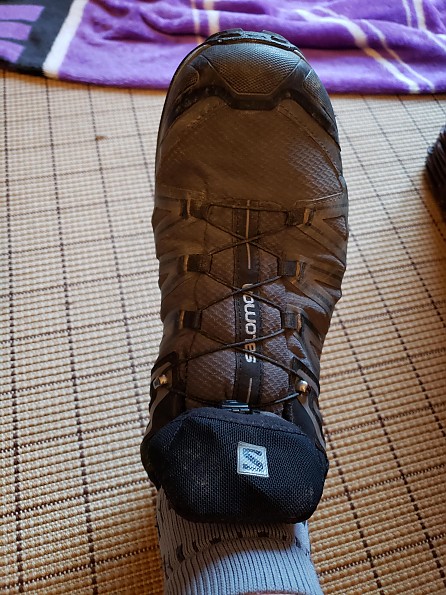
Personally, I like this system. It's very easy to fine-tune how tight your shoes feel during a hike, and I like having pressure distributed evenly across the top of my foot.
Soles/Traction
Salomon did a great job with these soles. The lugs are reasonably aggressive; they do a decent job shedding mud and debris.
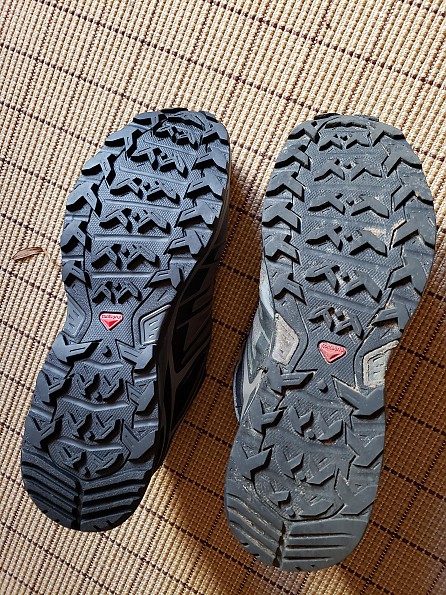
These are near-excellent soles for traction. The only surface where they don't shine is smooth, dry rock slabs, where a shoe with slightly softer and more sticky rubber and more surface area touching the rock (approach shoes) are a better choice.
It's hard for me to exactly say how many miles I have put on these shoes, but they became my primary low hiking shoe and probably went at least 400 miles over their life—and it could be a fair bit more than that. As you can see, the high wear areas in the middle of the forefoot and the outer part of the heel, the lugs are at least half worn-off, with the heel treads worn flat at the outside corner. Short of the hard Vibram block soles welted to my leather hiking boots, which are extremely durable but not great for traction, these have worn very, very well in my experience.
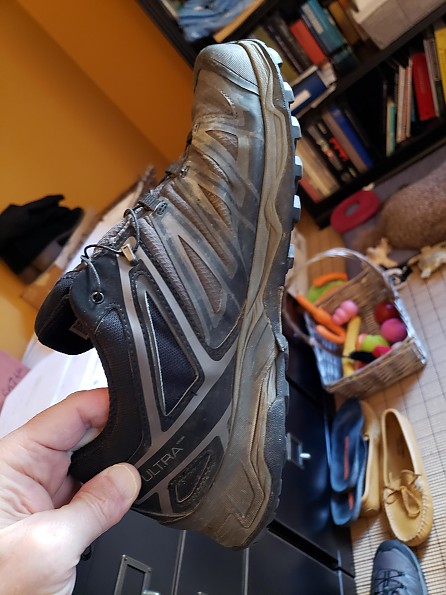
Durability
I already touched on this in other parts of the review, but I have been impressed with how these shoes held up. The uppers, inner lining, laces, and soles are still in pretty good shape after 18 months. The only place where I have really felt the wear is in the midsole, particularly under the forefoot.
EVA invariably compacts over time, losing some of its cushioning properties. I weigh over 200 pounds, and crushed midsoles are the number one reason I end up replacing lightweight shoes like this. [full leather boots don't have this issue because the midsoles are so hard, but they are also much less forgiving than this shoe.]
Takeaways
With the caveat that the most important metric in choosing a hiking shoe is how it fits your foot, and some brands work better for some people, Salomon's X Ultra 3 GTX is a top-notch low hiking shoe. It's light, sturdy, waterproof, and offers excellent traction. Though speed laces were not my preference, I have grown to appreciate them, particularly on such an outstanding shoe.
Background
18 months of walking and hiking (on the old pair) on flat trails, steep slabs, jagged rocks and talus.
Source: bought it new
Price Paid: $125
There is a reason it is the best selling shoe in the line.
Pros
- Great traction
- GTX works flawlessly
- Available in wide
Cons
- Very foot-shape specific
A review of Salomon shoes:
- The Ultra (Ultra 3 GTX)
- The Speedcross
- The Odyssey
Ultra: The Ultra has a great arch support last (the "last" is the framework style of the shoe) but is too narrow for me. I used a pair for a section hike. It gets great reviews. If it just were not so narrow, I'd be wearing them to hike now. But my feet hurt every night when I wore them on a section hike. They do make the Ultra in a Mid that is a wide, but I'm not interested (at least now) in a Mid.
Speedcross: The Speedcross is the best selling Salomon shoe, and comes in a wide. It just has an extended arch (feels like a bar of soap instead of an arch—a little longer and broader than I'm used to) and I just couldn't make my feet like it.
Odyssey: The Odyssey is the one they are getting ready to market for through hikes and long distance hikers (they are even releasing a redone one in February of 2019 named the Odyssey Triple Crown). It is breathable, quick drying, and has a high wear sole (designed more for trail hikers and durability). It even has a redesigned/restructured mid that will resist breakdown so the shoes will be good for as long as the sole lasts.
I special ordered a pair through my local REI (so I could return them if they were a bust). And...and...it has no arch support to speak of. The flattest shoe I've tried. It is intentionally wider (hikers feet widen out). I liked everything else, other than my feet were uncomfortable in them immediately and it didn't get better regardless of what I tried.
So, back to The North Face Ultra 110 GTX, especially as it actually feels better on my feet with a backpack.
I've tried all the various Salomon incarnations, trying to regain the feel of the Ultra without the "too narrow" and it just hasn't happened, at least without giving in and going to a mid, which I don't want to do.
Source: bought it new
Price Paid: $140
Your Review
You May Like
Specs
| Men's | |
|---|---|
| Price |
MSRP: $150.00 Historic Range: $74.98-$150.00 Reviewers Paid: $125.00-$140.00 |
| Lacing system |
Quicklace |
| Waterproofness |
GORE-TEX |
| Anatomical fit |
Standard fit |
| Drop |
11 mm |
| Weight |
380 g |
| Women's | |
|---|---|
| Price |
MSRP: $150.00 Historic Range: $44.83-$159.95 |
| Lacing system |
Quick-lace |
| Waterproofness |
GORE-TEX |
| Anatomical fit |
Standard fit |
| Drop |
11 mm |
| Weight |
330 g |


